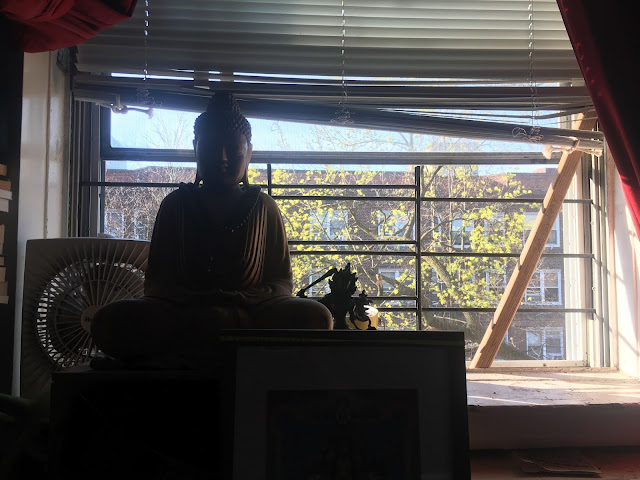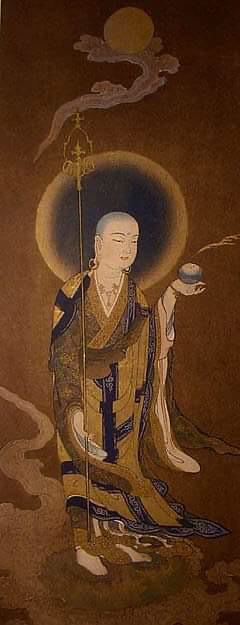Some things are so deep you can learn about them your whole life. Like psychotherapy, psychology, literature and Buddhism.
Yesterday was Avalokiteshvara's birthday. Not sure how a archetypal buddha can have a birthday, but I need to commit more, so hey, he's a deity. We make the world with our minds, n'est pas?
"The first birthday falls on the 19th day of the 2nd Chinese lunar month. The second birthday falls on the 19th day of the 6th Chinese lunar month and the third birthday falls on the 19th day of the 9th Chinese lunar month." I'll have to take your word for it. The Chinese calendar is different than the Gregorian calendar which is what is followed around me, so much so that I didn't even know it was called the Gregorian calendar. The Chinese calendar has a leap month! So anyway, I'm not going to be able to verify that yesterday was Avalokita's birthday, but I'll take the word of people in Singapore. I chanted the mantra some to celebrate, and read the 25th chapter of the Lotus Sutra.
Today is Samantabhadra's birthday! Now I don't remember Samantabhadra but he is associated with practice and meditation. I like that. I had to pull out my trusty Meeting The Buddhas by Vessantara.
Sundhana is supposed to have traveled all over and studied with all the great teachers, and then he meets with, who culminates all his teachings and is the pinnacle. Samantabhadra has a lavish vow of making offerings to the Buddhas that is referred to in some Tibetan pujas. They imagine they are giving great offering like Samantabhadra.
Samantabhadra appears in two sutras: The Lotus Sutra (Chapter 26), and Gandavyuha Sutra (The Excellent Manifestation Sūtra). So for devotion, I will read the 26th chapter of the Lotus Sutra with devotion, to imbue the magical spirit of these lovely deities. But Chapter 26 is about medicine buddha, Bhaisajyaguru. Opse. My info was wrong. Turns out it's at the end, the Samantabhadra Meditation Sutra. (Online version)
Sundhana learns from Manjushri: "The Gaṇḍavyūha suggests that with a subtle shift of perspective we may come to see that the enlightenment that the pilgrim so fervently sought was not only with him at every stage of his journey, but before it began as well—that enlightenment is not something to be gained, but "something" the pilgrim never departed from." (Wikipedia)
Sndhana learns from Samantabhadra: "wisdom only exists for the sake of putting it into practice; that it is only good insofar as it benefits all living beings. Samantabhadra concludes with a prayer of aspiration to buddhahood, which is recited by those who practice according to Atiśa's Bodhipathapradīpa"
I like that this is put in it's epistemological place.
Samantabhadra is revered in Sri Lanka. Their main shrine to him is in Ratnapura, 101km southeast of Kandy, at Maha Saman Devalaya. If I were getting $341m like Lindor, would I spend money to travel there? I think I would.
In Japan Samantabhadra is Fugen and rides an elephant and is green. He has 10 vows.
And in north America, Samantabhadra ... I hope to see the day we have a unique twist of devotion that cottons to our culture, time and place.
I'll end with a trippy ecstatic part of the sutra and his elephant:
"The Bodhisattva Universal Worthy is boundless in the size of his body, boundless in the sound of his voice, and boundless in the form of his image. Desiring to come to this world, he makes use of his sovereign psychic powers and compresses his stature to a smaller size. Because the people in Jambudvipa have the Three Weighty Obstacles, by the power of his wisdom he appears by transformation as mounted on a white elephant. The elephant has six tusks, and seven limbs, (supports its body on the ground?). Under its seven limbs, seven lotus flowers grow.
The elephant is white as snow, the most brilliant of all shades of white, so pure that even crystal and the Himalaya Mountains cannot compare with it. The body of the elephant is four hundred and fifty yojanas in length and four hundred yojanas in height. At the tip of the six tusks rest six bathing pools. In each bathing pool grow fourteen lotus flowers as large as the pools. The flowers bloom majestically, like the king of celestial trees.
On each of these flowers sits a jade maiden whose countenance is red as crimson and whose radiance surpasses that of a goddess. In the hand of that maiden five harps appear by transformation, each of them with five hundred musical instruments as its accompaniment.
Five hundred birds fly up, including ducks, wild geese, and mandarin ducks, in color like precious gems, and settle among flowers and branches.
On the elephant's trunk there is a flower with a stalk the color of a red pearl. Its blossom is golden, its shape is still a bud that has not yet blossomed.
After witnessing this event, if a person further repents of his offenses, and contemplates the Great Vehicle attentively, with entire devotion, and ponders it in his mind without cease, he will be able to see the flower spontaneously bloom, and radiate with a golden color. The blossom of the lotus flower is made of kimsuka gems en laid with wonderful, pure Mani jewels; the stamens are made of diamond.
A transformation Buddha appears, sitting on the petals of the lotus flower with a host of Bodhisattvas sitting on the stamens. From the eyebrows of the transformation Buddha a ray of light appears and enters the elephant's trunk.
This ray, the color of a red lotus flower, emanates from the elephant's trunk and enters its eyes; the ray then shines from the elephant's eyes and enters its ears; it then comes from the elephant's ears, illuminates its head, and changes into a golden platform.
On the elephant's head there are three transformed attendants: one holds a golden wheel, another a jewel, and another a vajra pestle. When the attendant raises the pestle and points it at the elephant, the latter immediately walks (a few steps?).
The elephant does not tread on the ground but hovers in the air, seven feet above the earth, yet the elephant leaves its footprints on the ground. The footprints are altogether perfect, marking the wheel's hub with a thousand spokes. From each hallmark of the wheel's hub grows a great lotus flower, upon which an elephant appears by transformation.
This elephant also has seven legs and walks after the great elephant. Every time the transformed elephant raises and brings down its legs, seven thousand elephants appear, all following the great elephant as its retinue.
On the elephant's trunk, in hue like a red lotus flower, sits a transformed Buddha who emits a ray from his eyebrows.
This ray of light, in similar fashion, enters the elephant's trunk.
The ray emerges from the elephant's trunk and enters its eyes;
the ray then shines from the elephant's eyes and again enters its ears; it then comes from the elephant's ears and reaches its head.
Gradually rising to the elephant's back, the ray is transformed into a golden saddle which is adorned with the Seven Precious Gems.
On the four sides of the saddle are the pillars made of the Seven Precious Gems, which are decorated with precious objects, forming a jeweled pedestal. On this pedestal there is a lotus flower stamen bearing the Seven Precious Gems, and that stamen is also composed of a hundred jewels. The blossom of that lotus flower is made of a great Mani-jewel.


















